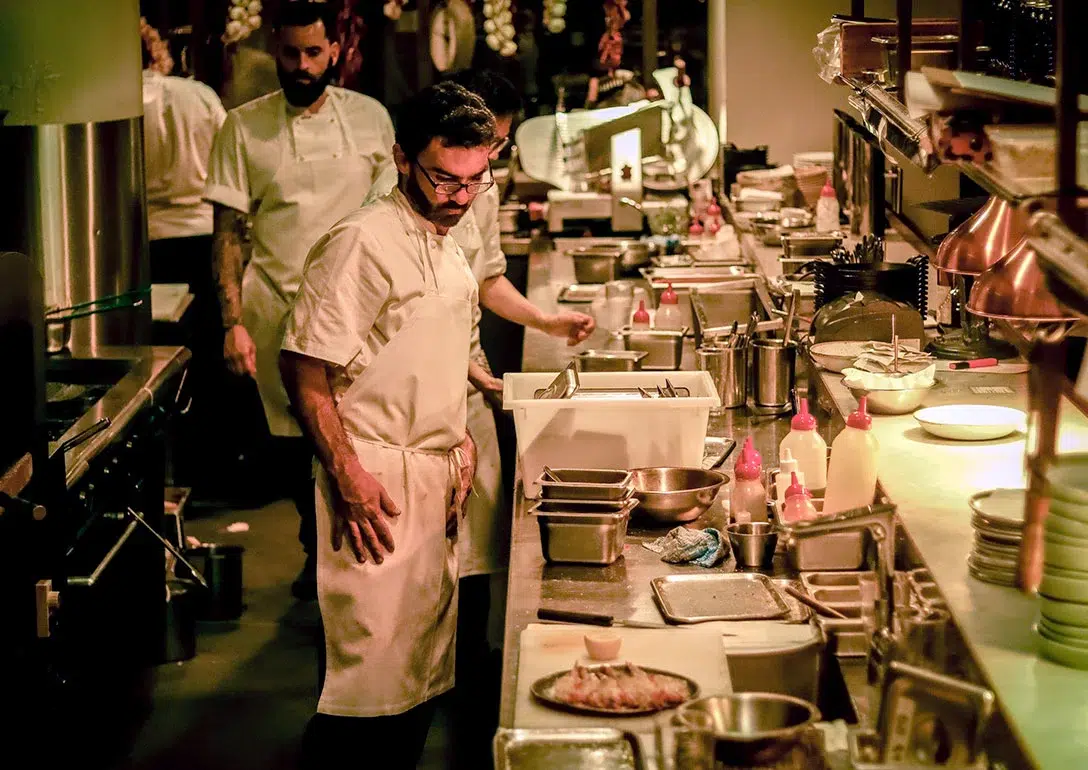Most restaurant operators will agree that inventory management is a frustrating task. From recording stock amounts to breaking down numbers into useable data, conducting checks on a regular schedule can get a little exhausting. With the right practices in place, you can make managing restaurant inventory faster, easier, and more of a tool for success than a dreaded task. This guide will take you through restaurant inventory management best practices and show you how to get the most out of your system.
The Importance of Restaurant Inventory Management Software
In the restaurant business, one of your most valuable assets is your supply stock. One of the core factors that will help you get ahead is how you manage inventory. Restaurant inventory includes all of the materials your kitchen staff uses to prepare menu items, from the main ingredients to the sauces and seasonings.
Your stock is an investment — one of the most significant and most frequent investments you’ll make. Typically, 25 to 35% of your entire operating budget goes towards food. When you purchase new stock, the goal is to use as much of it as possible with little to no waste. Every completed order that makes it to a satisfied customer is a return on your initial investment. Any wasted that doesn’t make it to a customer decreases your potential profits.
Because food waste reduces your revenue, it’s essential to minimize it as much as possible. From mistakes in the kitchen to solving complaints, losing some of your stock is inevitable. However, there are ways you can reduce your losses.
For one, use excess inventory by offering creative specials. If you have too much of an ingredient and know you can’t use it all before it spoils, create a dish you can sell for a low price, while supplies last. You can also donate surplus stock to non-profits, which saves you from having to toss unused supplies and helps people in need.
You can also cut down on the waste your customers leave on their plates. Pay attention to serving sizes — restaurant entrees are often more substantial than a recommended meal. If there are individual dishes that people often leave unfinished, try reducing the ingredients you use and serve a smaller version. You can also create a section on your menu for small plates that customers can choose from if they know they won’t finish a full entree.
These solutions are a part of initiating inventory control and management practices.
What Is Restaurant Inventory Control?
Restaurant inventory control is essential. You need it to know precisely how much your restaurant is — or could be — earning. Inventory control acts simultaneously as a tool for loss prevention and a way to more accurately measure your profitability.
When you use inventory tracking, you’ll have a record of all the supplies your restaurant receives, how much goes through the kitchen, and what you have left at the end of each night. These factors will provide you with the best understanding of how your staff is using supplies and what customers are buying. If you notice you need to reorder a specific item sooner than usual, you should know why.
While it would be excellent if all of your product went to happy customers, that is rarely the case. There are several areas of loss to which you should pay attention. The list includes accidental spills, kitchen and waitstaff mistakes, extra usage due to customer complaints, employee meals, and even theft. Not every ounce of your supplies is going to make it on to a plate, and if they do, they could still become a loss.
Once you know the percentage of your supplies that go to waste, you can accurately determine your profits for any period.
How to Take Restaurant Inventory
Understanding what inventory management is and why it’s essential to do right is the first step to implementing a better system. Next, you need to learn the best methods to use when creating a working system. Here are some of the top restaurant inventory management tips:
1. Know the Inventory Terms
Before you implement an inventory management system in your restaurant, it’s essential to have as much background knowledge as possible. Here are some of the top terms you should know:
- Costs of goods sold (COGS): As you use inventory, you should keep track of your COGS for specific periods. COGS is the price of all the stock used to make the meals and drinks you serve. To calculate it, first take the sum of your existing inventory at the beginning of a given period and any additional inventory purchased during the period. Then subtract the cost of your remaining inventory at the end of the period.
- Catch weight: Typically, when you buy unprocessed foods, you’ll receive orders in approximate weights, or catch weights. For items like meats, if you purchase a certain amount of pounds per week, the weight fluctuates over and under slightly. It can affect your inventory management, so you should consider it in your inventory and expense records.
- Sitting inventory: Either measured in dollars or the amount of product, your sitting inventory is the stock you have stored in-house.
- Food cost percentage: The cost of the inventory it takes to create a dish divided by your menu price is its food cost percentage.
- Inventory turnover ratio: The rate at which your kitchen uses its stock over a specific period — typically measured over a year — is your inventory turnover ratio. You can calculate it by finding your COGS and dividing it by the average of your beginning and ending inventory.
- Par level: The minimum amount of inventory your restaurant can maintain to meet your customer’s demands, all while avoiding unnecessary waste. To calculate an estimate of your inventory par levels, add your weekly inventory and stock use and divide that number by the deliveries you receive per week.
- Recipes: The quantities of ingredients your staff uses to create a specific dish is called a recipe.
- Estimated usage: You can find your estimated usage of an item to see how long your stock of that ingredient will potentially last. To calculate estimated usage, divide your sitting inventory of the item by the average of how much of that ingredient you typically use over a specific period.
- Theoretical vs. actual usage: Your servers and restaurant POS system may have a different count than what’s actually missing from your inventory. This discrepancy is crucial to monitor. If you don’t know about accidents, such as spilled ingredients or replaced orders, you can’t log them as food waste. Ultimately, this causes an imbalance in the usage report.
- Variance: The variance of your inventory is the actual usage subtracted from the theoretical usage.
- Waste: There are two types of restaurant food waste — pre-consumer and post-consumer. Pre-consumer is before the food gets to your customer, and post-consumer is anything the customer leaves unfinished once they’ve received it. You need to find ways to reduce the pre-consumer part if you want to help your bottom line and reduce unnecessary waste.
2. Organize Your Supplies
One of the most crucial parts of being able to manage inventory quickly is organization. Every item should have a place. If your staff needs to move anything, they should be expected to put it right back once they’re finished using it. If you want to ensure you and your employees can find everything quickly, organize your inventory into larger groups, and create labels for your storage shelves.
You can also create a map or spreadsheet of where each group is as sort of a cheat sheet for quick reference. Regardless of how you organize, be sure to keep your shelves and storage areas clean, and always rotate your stock to avoid food waste.
3. Have the Same Staff Members Take Inventory
Once you have your inventory organized, you should train a few reliable, long-term employees to help you track it. Your best options are likely your managers and chef. They can work closely with the inventory and identify any inconsistencies or issues. With experience and time, they’ll quickly recognize the correct patterns and flow of your inventory, as every restaurant’s usages are unique.
While training will get them on the same page, you also need to explain to your managers why their job is essential and incentivize good work. Explain how inaccurate inventory tracking affects your profits and that even small mistakes can have significant consequences. Also, consider offering monetary bonuses to your trackers when they find errors, propose useful changes, or generate savings.
4. Practice First In, First Out (FIFO)
FIFO is a method of storing and rotating your stock to ensure none of your ingredients spoil. When stocking new inventory, your staff should move older ingredients to the front of their storage area. Moving older ingredients to the front ensures your chef uses them before opening newer containers.
One way to help avoid creating waste is by labeling stock with use-by dates or marking older containers as ingredients to finish before opening new ones. If you have a tight organization system where there’s a potential for confusion, labeling might be helpful. It’ll also keep your staff consistently aware of how much stock they’re using over time. If they can’t make it through the older ingredients before their use-by date, it may be an indicator to order less.
5. Be Consistent with Managing Inventory
To take consistent and accurate measurements of your inventory, you have to work from a regular schedule. Many of the calculations need to reference specific periods, such as a week or month. If you are inconsistent with timing, you’ll end up with data that’s all over the place. It won’t give you an exact measure of COGS, inventory turnover, par level, usage, or variance.
However, you can set different schedules for varying types of ingredients. Frequently used stock and perishables will have a faster turnover rate, so you may want to check them daily. Non-perishables and bulk will last longer, so you can check them once a week. As long as you keep the dates and times consistent, you and your management team will notice the patterns and can make any necessary changes.
6. Set Restaurant Inventory Goals
Once you understand how fast your stock shuffles through your kitchen and your restaurant’s average inventory measurements, you should start setting goals. Whether you go by sales percentages, days in inventory, or turnover, targeted objectives will help your staff aim at improvement in specific areas. You can also choose the period in which you expect progress, from weekly changes to as long as yearly.
Merely setting the goals won’t make them a reality, though. You and your management team need to monitor performance and create solutions to potential roadblocks. Work with your kitchen staff to see if there are any snags you can incorporate into a new goal.
7. Train Your Staff Effectively
While it’s essential to have a small team to help you with the logistics of inventory management, the rest of your employees should be in on it too. Managers will focus on larger jobs, such as recording inventory reports and identifying potential issues. But you and your managers need to get the rest of the staff involved daily.
Train your kitchen hands and waitstaff to be aware of inventory issues. Teach them why their actions are essential, such as keeping an eye out for variances and carefully rotating stock. Since they deal with the ingredients the most often, make your line cooks and kitchen staff responsible for recording any pre-consumer waste. Whenever they make errors or have to discard rotten food, tell them to make a note of it.
8. Maintain a Sheet for Food Waste and Inventory Errors
Food waste and errors can significantly impact your inventory records. While you should try to avoid them whenever possible, they’re inevitable. Currently, only about 47% of restaurants track their waste, a number that should be much higher. Creating a record sheet specifically for these mistakes will show you everything your inventory list doesn’t. Knowing how much food waste your kitchen produces over a specific period will provide you with insight on goals to save money and stock.
For example, if your kitchen staff has to toss rotten food or out-of-date ingredients regularly, you may need to order less in the future or use them faster. Or, if customers return items because they weren’t correct, your servers may need a better method of taking down orders. To maintain accurate records, you should include time and date, item, amount or weight, reasoning, and the reporting employee’s initials on your food waste sheet.
9. Forecast Food Inventory Demand
As a whole, food waste in the restaurant industry amounts to about 11.4 million tons per year, making it a huge factor in profit losses and inventory mismanagement. A large portion of this waste comes from overstocking, resulting in excess food spoiling before cooks can use it. To avoid making this mistake or minimizing your margin of error, you should include forecasting in your inventory management practices.
Forecasting involves calculating ingredient usage over a certain period and making estimates on how much you’ll need to order next. The best method is to use technology that tracks and analyzes necessary data, such as purchasing and food sales. With the right insights, you can reduce the percentage of food waste you produce and save money on your next stock.
10. Don’t Use Pen and Paper to Track Inventory
Pen and paper inventory tracking is a thing of the past. With the current restaurant technology available to all businesses, trying to keep an accurate inventory by hand will slow you down and leave more room for human error. Considering the amount of math and analysis that goes into inventory management, using a restaurant software system will significantly benefit your efforts.
Inventory tracking software makes recording more manageable and provides you with insights you can’t get from a spreadsheet. It can crunch numbers for you and analyze patterns. Some systems can even alert you when a particular ingredient may be getting low. Their convenience will take a lot of the hassle out of inventory management, and will allow your team to reach their goals efficiently.
Optimize Your Restaurant Inventory Management with CAKE
Understanding how to manage restaurant inventory is an essential part of running a restaurant. Make your system as straightforward as possible with CAKE. Our software solutions and informational materials will help you create user-friendly, intuitive inventory management practices. CAKE’s integrated tools will make analysis a breeze — you won’t have to dread those daily, weekly, and monthly check-ins any longer.
With the right restaurant POS system and know-how, you can turn the necessary task of conducting inventory into one of your restaurant’s most valuable sources of data.





